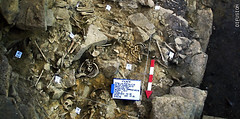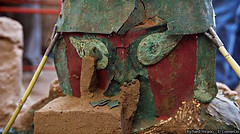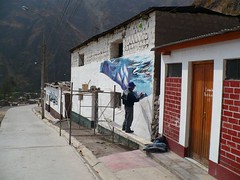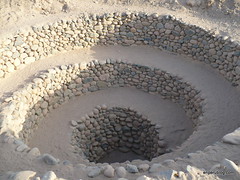Yes, Lima, just like any international city or capital, is afflicted by the curse of US fast food chains. These sprung up after the city was flooded with foreign investment and new prosperity after its dark 80s period. These are of course enjoyed by those who found themselves able to afford to eat in them, but, were they able to kill off home-grown options in the gastronomic capital of the Americas? Not at all.
Category: "Lima City Guide"
Eating in Lima – What not to miss – China-Influenced
Part four of what not to miss when eating in Lima.
A boom in Chinese immigration to the Peruvian coast in the 1800s brought with it a new style of cooking and new flavours. Though this meant importing some traditional ingredients, in the majority of cases Chinese families and new Chinese restaurant owners had to make do with local ingredients. This fusion of two culinary worlds created Peru’s famous chifa, the name by which Peruvians call Chinese food.
Peruvian restaurants seize on opportunities abroad
As Peruvian food becomes better known throughout the world, more Peruvian restaurants are seizing on the opportunity to expand into foreign markets. Some have already done this – Pardo’s Chicken is one, and Gastón’s La Mar is another – franchises of famous Peruvian restaurants are now found in the US, Mexico, Venezuela, Colombia and Chile.
Mejorando Mi Quinta
One of the most distinctive sights in Lima are its ageing 50s and 60s era buildings. The majority of these in districts such as Jesús María have long since been converted into multi-family residences, while others were built specifically for this purpose.
Parque de las Leyendas, zoo and ruins
Parque de las Leyendas, a zoo built among the ruins of a pre-Inca city, somehow manages to mix ecology and archaeology, attracting hundreds of Peruvian families each day. Off the usual tourist trail for foreigners, it could make a good half-day trip and is a great chance to learn about Peru’s rich biodiversity and about Lima’s ancient past.
Eating in Lima – What not to miss – Afro-Peruvian
Part three of what not to miss when eating in Lima.
The line that divides the worlds of Creole and Afro-Peruvian food, music and culture generally are ever more blurred together as the melting pot effect takes hold. Black Peruvians contribute heavily to today’s coastal culture which for convenience is often just called “criollo”. What gastro-tourists in Lima are most concerned with though is what Afro-Peruvians brought to the dinner table, and boy did they deliver.
Carnavales
February is over, it is finally safe to come out of hiding and explain how carnival is celebrated in Peru. While Brazilians are building floats and flailing around, most Peruvians have to look over their shoulders. I have to mention Brazil because to most foreigners, the word carnival is synonymous with Peru’s largest neighbour. It may come as a surprise to many though that carnival is a big deal in Peru too – in fact, the next biggest and best carnival experience in the Americas is hosted in the north of the Andean country, in beautiful Cajamarca. Here the hugely anticipated event is the local population’s reason for being – and you can’t blame them, read about it here.
Female Traffic cops rule the streets of Lima
Peru’s transit police aren’t famous for their honesty or work ethic. Anything but. In line with all Government employees, they are so underpaid that they see corruption as the only way to make a decent living. For transit police, this usually involves pulling over those drivers who violate traffic laws and writing up a ticket… a ticket that can be ripped up on the spot though, should you be kind enough to collaborate with a little lunch money, beer money, a holiday bonus if it is nearing Christmas, or even money for gasoline.
Eating in Lima – What not to miss – Creole classics
Part two of what not to miss when eating in Lima.
Other than sea food, the coastal population in Lima, a mix of Spanish and indigenous descendents known as creoles, have a wide selection of rich-tasting dishes for visitors to try.
Eating in Lima – What not to miss – Seafood heaven
Part one of what not to miss when eating in Lima.
Blessed with a long Pacific coast with some of the richest fishing grounds in South America, Peru’s sea food offerings are outstanding. Lima, birth place of the majority of these dishes, can not be visited without also visiting a cevichería.
Bon Appétit declares Lima “The Next Great Food City”
It had already been declared the gastronomic capital of the Americas and the home of one of the world’s twelve great cuisines. Now the city of Lima continues is rapid climb to the top of food-lover’s travel itineraries after gastronomy magazine Bon Appétit declared it their Destination of the Year 2009.
Curich and the cremolada
It’s summer in Lima. The days are hot and they are long. The sun pushes you down with its full force, as if a heavy weight on your shoulders, and the humid air is thick like treacle. The gentle sea breeze along the cliffs of the Costa Verde in Miraflores seems to disappear during the hottest hours of the day, just when it is needed most. Ice cream sellers whistle as they ride by on their ice cream dispensing bikes… but you are thirsty and a thick ice cream won’t refresh you beyond the 30 seconds it takes to devour it. What is there that can save you from collapsing into a heap in the middle of the street?
A cremolada, a cremolada from the home of cremoladas, a cremolada from Curich.







![Peru’s hard-hitting Oscar film hope divides opinion [Featured]](http://farm5.static.flickr.com/4002/4407554620_1f45162f92_m.jpg)


